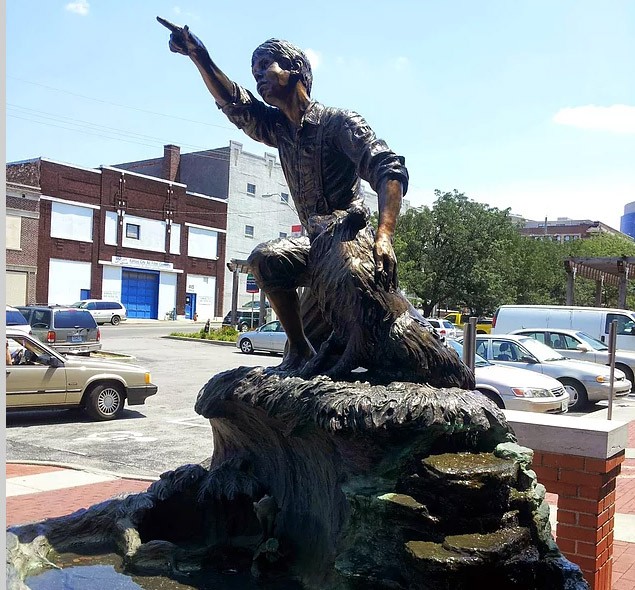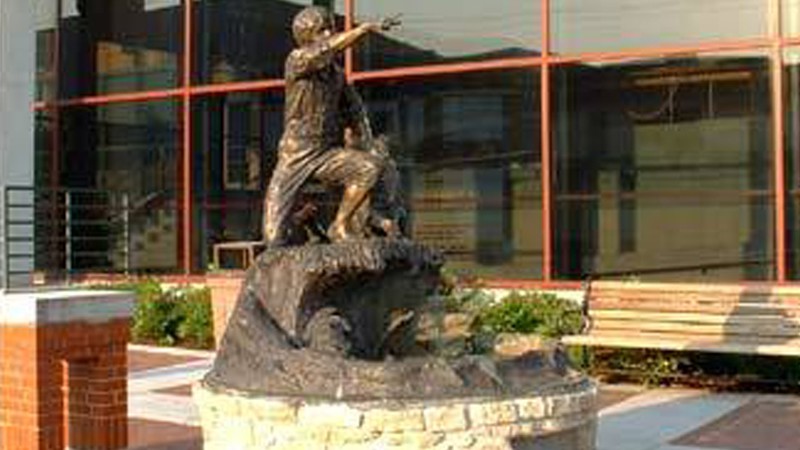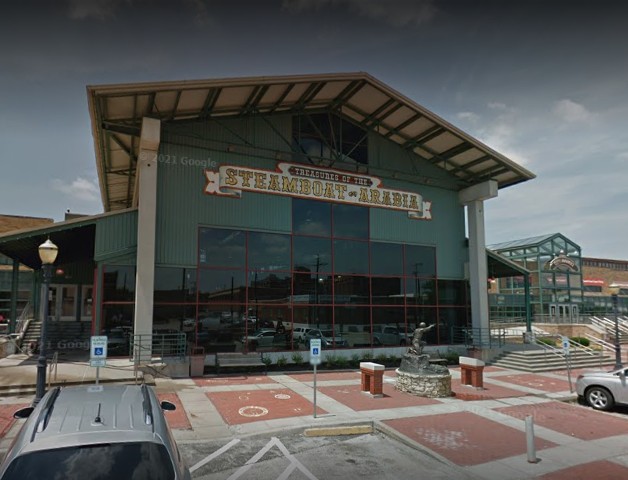Vision Fountain at the Arabia Steamboat Museum
Introduction
Text-to-speech Audio
The Vision Fountain adorns the entrance of the Arabia Steamboat Museum in the River Market area, located north of downtown Kansas City, Missouri. Jim Brothers designed the sculpture that memorializes local businessman Cliff C. Jones, Jr. for his work in redeveloping the River Market area, a historic area of Kansas City. Meanwhile, the museum is home to numerous nineteenth-century artifacts, notably the recovered Steamboat Arabia, which sank with its 200 tons of mystery cargo near Kansas City on September 5, 1856.
Images
The Vision Fountain

The Vision Fountain

Steamboat Arabia Museum & Vision Fountain

Backstory and Context
Text-to-speech Audio
The fountain and museum are located in Kansas City's River Market neighborhood, once known as Westport Landing, the first and oldest incorporated district in Kansas City. Established in 1821 as an early French fur trading post, operated by François Chouteau of the prominent Chouteau family, the area slowly matured into a city. The Westport Landing name stems from the dock on the Missouri River used for the exchange of goods targeted for the Westport community three miles to the south on higher ground operated by John Calvin McCoy. He and fourteen other pioneers moved to the area in 1830, finding Chouteau's farming area suitable for settling. Though he was intent on converting Shawnee Indians into Christians, he also opened a general store, developed roads, and cleared a trail to the river landing. Over time, Westport Landing outgrew Westport, eventually growing into modern-day Kansas City.
The landing area served many steamboats that traversed the Missouri River, including the Steamboat Arabia, one of the numerous steamboat shipwrecks of the treacherous Missouri River; nearly 400 steamboats sank on the 2,500-mile river. In September 1856, the Arabia carried 200 tons of cargo intended for general stores and homes in sixteen Midwestern frontier towns. As was typical on the river, the steamboat hit a tree snag and sank just six miles west of Kansas City. The Arabia and its cargo sat buried underground for over a century. Indeed, because the river changed course over the years, searchers found the ship n the 1980s nearly forty feet deep beneath a Kansas cornfield, which had protected Arabia's payload from light and oxygen, allowing it to remain remarkably well preserved.
One year after the Steamboat Arabia sank, the formation of City Market in Westport Landing, or "The City of Kansas," took place. City Market consisted of a public square and large open-air farmers’ market. Sometimes referred to as River Market because of its proximity to the Missouri River, City Market offered visitors a chance to buy fresh products from farmers, while the associated public square served as the home to political rallies, demonstrations (such as medicine shows), and entertainment.
The market has gone through many iterations over the last 150 plus years, from its beginnings as a venue for market commerce, political rallies, and medicine shows. During the 1970s, developer Marion A. Trozzolo applied the name "River Quay" to the area to capitalize on the neighborhood’s early French connections as a fur trading post operated by François Chouteau. Trozzolo hoped to develop the neighborhood into a destination for restaurants and bohemian shops. However, a mob war developed; they burned and planted bombs in three establishments, resulting in the deaths of several mobsters.
But, during the 1980s, Cliff C. Jones, president of the Market Area Development Corporation, remarked on a new plan to restore the area to its former glory: ''We have to do this. We have to clean this area up. This is the very doorstep of Kansas City.''
Jones, who majored in economics at Princeton and graduated with honors, served in the Navy during World War II before returning to Kansas City to work for R.B. Jones & Sons Insurance Co., eventually becoming its president and CEO. Indeed, he enjoyed extraordinary success in the business world. Additionally, in 1948, the Junior Chamber of Commerce elected him president and in 1957 he served as president of the Greater Kansas City Chamber of Commerce. Moreover, he founded the Civic Council of Kansas City and served as its second president. Suffice it to say, he dedicated much of his life developing businesses in Kansas City before adding "president of the Market Area Development Corporation," to his resume.
The 1980s renovation of the River Market neighborhood proved wildly successful. Since its renovation, the market has transitioned into a hub for shopping, dining, and other service-orientated commercial enterprises. The area has received critical acclaim.
The vision to restore the River Market neighborhood into a modern marketplace, much as it was during the 1850s, allowing for the preservation of a historic part of Kansas City. Meanwhile, the fountain that honors the River Market visionary is located near a museum that not only celebrates a lost ship, but a significant aspect of Kansas City history: the Missouri River, from steamboats and fur trading to today's restaurants, hotels, and recreational activities.
Cite This Entry
Powers, Mathew. "Vision Fountain at the Arabia Steamboat Museum." Clio: Your Guide to History. September 15, 2022. Accessed April 29, 2025. https://theclio.com/tour/2255/1
Sources
The Arabia Steamboat Museum. Accessed July 2, 2022. https://www.1856.com/.
"Bridge Opening August 2011." National Park Service. nps.gov. 2011. https://www.nps.gov/safe/learn/historyculture/upload/Westport-Landing-exhibits-final-aug11_2011-2.pdf
Dornbrook, James. "KC's business and civic community mourns the loss of Cliff Jones Jr." (Kansas City) Kansas City Business Journal. Mar 10, 2014. https://www.bizjournals.com/kansascity/news/2014/03/10/cliff-jones-jr-death.html.
Fitts, Orvis. "The Town of Kansas Site to be a Reality." Westport Historical Society. Accessed July 2, 2022. https://www.westporthistorical.com/town-of-kansas.
"History of the Kansas City River Market." Accessed July 2, 2022. https://kcrivermarket.com/history-of-the-kansas-city-river-market/.
Memorial: Cliff C. Jones ’41. Princeton Alumni Weekly. October 2014. https://paw.princeton.edu/memorial/cliff-c-jones-%E2%80%9941.
New York Times News Service. "Kansas City Set to Shore Up Old River Area." (Chicago) Chicago Tribune. Jan 19, 1987. https://www.chicagotribune.com/news/ct-xpm-1987-01-19-8701050543-story.html.
Powers, Mathew. "François Chouteau & Native American Heritage Fountain." Clio: Your Guide to History. June 30, 2022. Accessed July 2, 2022. https://www.theclio.com/entry/153588
Roe, Jason."In for the Landing." Kansas City Public Library. kchistory.org. Accessed July 2, 2022. https://kchistory.org/week-kansas-city-history/landing.
https://kcparks.org/places/_the-vision_-fountain-2/
https://kcparks.org/places/_the-vision_-fountain-2/
From Google Maps, https://www.google.com/maps/uv?pb=!1s0x87c0f08b1db80791%3A0xa0f9ff1469a91714!3m1!7e115!4s%2Fmaps%2Fplace%2FArabia%2Bmuseum%2Bkansas%2Bcity%2F%4039.1094536%2C-94.5809583%2C3a%2C75y%2C273.42h%2C90t%2Fdata%3D*213m4*211e1*213m2*211sMVtHeVpuYZzCmUjFZAJnbw*212e0*214m2*213m1*211s0x87c0f08b1db80791%3A0xa0f9ff1469a91714%3Fsa%3DX!5sArabia%20museum%20kansas%20city%20-%20Google%20Search!15sCgIgAQ&imagekey=!1e2!2sMVtHeVpuYZzCmUjFZAJnbw&hl=en&sa=X&ved=2ahUKEwiBlsO379v4AhXcmWoFHVAxBS0Qpx96BQiaARAI

